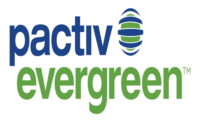
Emergent Technologies, LLC, Chanhassen, Minn., has teamed with Plastic Technologies, Inc. (PTI) to commercialize a first-of-its-kind, two-compartment polyethylene terephthalate (PET) container, called the Smiler .
“The driving force behind the concept was to give brand owners the opportunity to market a single-serving of two compatible products-such as milk and cookies-within one portable container,” explains Bill Weber, president and general manager, Emergent. “Every time we showed the concept, people smiled and that’s how we came up with the brand name.”
“Less than 20% of all Americans use vending machines regularly, because they don’t like the extra cost and calories that typically come with full-size vended products. Our research shows, however, that a sizable number of consumers like the idea (and functionality) of getting a little less snack and a little less beverage for less than the cost of two full-sized products. With all the on-the-go eating we see today, people seem to like the idea of popular snack-and-drink combos that can simply 'tide them over' until they can sit down for a real meal.”
The proprietary Smiler technology enables bottles/containers to be injection blow molded into different shapes and sizes. The larger, top compartment holds the liquid, while the bottom holds the snack item. Additionally, both can be used for dry products and/or non-food items.
The second or bottom compartment is created by drawing the base upwards which forms a small cavity into which a heat-sealed portion cup, containing solid, granular or powdered products, can be inserted and held by friction. The base opening can then be closed using a variety of heat-seal or pressure-sensitive materials/methods. The top compartment relies on a traditional finish and closure.
Having done extensive research on everything from rising obesity rates to portion control to functional foods to on-the-go food consumption, Emergent saw a dual-compartment container as a way to help meet multiple consumer objectives. However, they needed to partner with a technology expert in order to transform their vision into a commercially-viable package. That’s when Emergent turned to PTI, a global leader in preform and package development, for assistance.
“We spent a lot of time looking for ways to push PET design and processing boundaries beyond what had previously been done. The biggest challenge was figuring out how to make a base cavity that was deep enough to house a second product. We went through multiple iterations over a year-plus to make sure that both the design elements and the blow molding process would meet performance objectives,” explained Scott Steele, vice president, PTI.
For example, in early iterations, the depth of the base cavity would cause the bottle to get hung up in the mold. An additional piece of hardware had to be designed to positively extract the bottle from the mold.
“On the material side of the fence, the objective was to get monolayer PET to work. We did not want to blend in additives to achieve performance attributes because that would negatively impact container prices, as well as have a potential negative effect on the recycling stream,” Steele said. “The key was determining the optimum ratios between the bottom and top cavities, coupled with the finish diameter.”
Containers have already been successfully produced for promotional events, but Emergent and PTI are now looking to bring the concept to the attention of mainstream brand owners. The first commercialization was a ball-shaped bottle used by Ohio Wesleyan University to help commemorate the signing of baseball legend Jackie Robinson by Branch Rickey (OWU ’04) of the Brooklyn Dodgers.
“We envision a wide variety of applications for the Smiler concept. In addition to vended snack and drink combos, after-the-game treats for youth sports, fund-raising tools and other promotional products, we also see the bottle being used to promote health and wellness, and even humanitarian causes. For example, you can insert a two-week supply of water purification tablets in the bottom cavity and air drop bottles into disaster areas even when roads are impassable and it’s not possible to land aircraft. The top cavity can be used to collect locally-available water, while one of the purification tablets from the bottom cavity can create first-response, drinkable water,” Weber said.
Emergent Technologies
www.emergent-technologies-us.com
Plastic Technologies
www.plastictechnologies.com.





